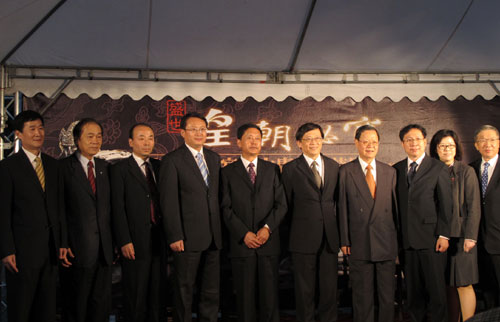Bureaus Exclusive
Relics from Famen Temple on display in Taiwan for 6 months
By Lu Hongyan (chinadaily.com.cn)
Updated: 2010-10-30 21:22
 |
Large Medium Small |
 |
|
Officials from Shaanxi province and Taiwan attend the launching ceremony of the exhibition. [Photo/chinadaily.com.cn] |
One hundred twenty relics from Northwest China's Shaanxi province which date back to the Tang Dynasty (618-907 AD) will be on display in Taiwan for nearly half a year starting from Oct 29.
Sixty-one relics are first-notch ones chosen from 2,499 relics unearthed from an underground palace in the Famen Temple and 59 are gold, silver and bronze ware, Buddhist statues and murals from an archaeological institute and several museums in Shaanxi, according to Pang Ya'ni, chief of the Shaanxi Provincial Cultural Relic Center.
It is the first time that such a large number of treasures from the underground palace of the Famen Temple are being exhibited, Pang said.
After the Buddha’s finger bone relic from Famen Temple was exhibited in Taiwan in 2002, Shaanxi and Taiwan started planning an exhibition of more relics from the temple.
The current exhibition will be held from Oct 29, 2010 to Jan 9, 2011 in the National Museum of History in Taipei and from January 21 to April 24 in the National Science and Technology Museum in Kaohsiung.
Speaking in the opening ceremony of the exhibition in Taipei, Zhang Wen, deputy chief of the Shaanxi Provincial Cultural Relic Bureau, said he believed the exhibition will further cultural exchanges between both sides of the Taiwan Straits.
The 1,700-year-old Famen Temple, renowned for storing a finger bone relic of the Sakyamuni Buddha, is located in Fufeng county in Shaanxi province.
The Famen Temple Museum was established in 1987 and includes most of the precious treasures from the Tang Dynasty (618-907 AD) which were removed from the underground palace that same year.
Gold and silverware, colored glaze ware, porcelain and silks are all on display.
Due to its popularity with tourists and their curiosity about the relics, two new exhibition halls were established in 2000. The exhibition area has been expanded from 500 square meters to 3,000 square meters.